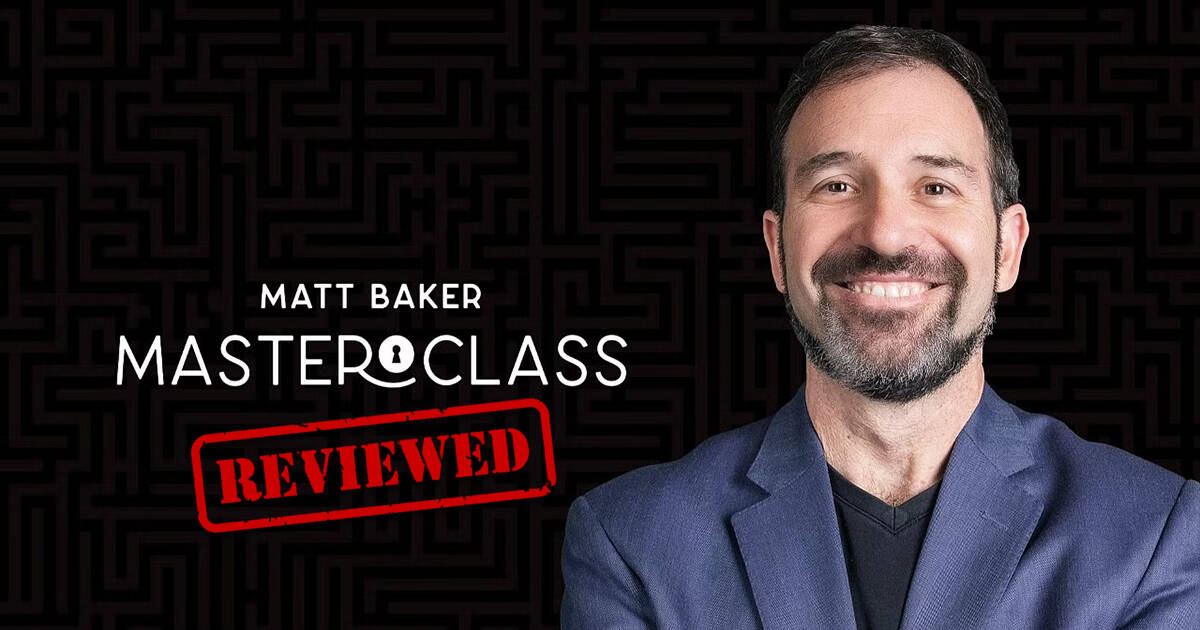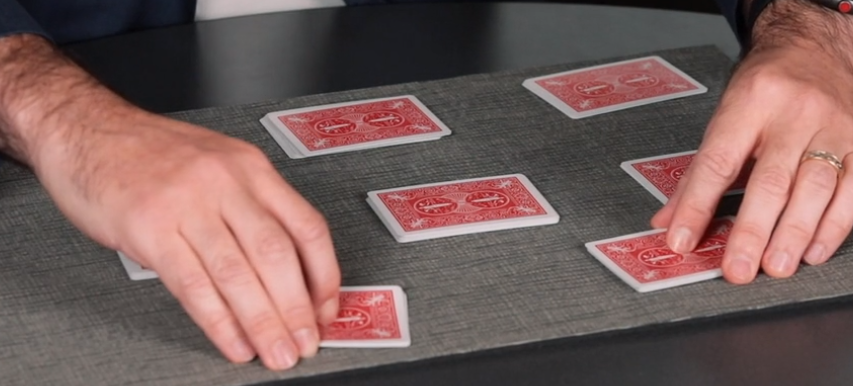
I've watched a few "Masterclass" lectures over the years, often they're multi-part videos and cover a range of topics that center around a specific theme. The Matt Baker Masterclass is no different. Except, it's the first Masterclass I've watched completely through!
If you're interested in card magic, The Buena Vista Shuffle Club, Simon Aronson, math, M&Ms, or a combination of all of the above, read below to see if this Masterclass is for you!
Masterclass Overview
This is a 3-part Masterclass split over 3 weeks. The first 2 weeks are actual lectures, the 3rd week is (or was) a live Q&A held over Zoom.
During Week 1, Matt is joined by Andy Gladwin and a layman, John. In Week 2, layman John returns and another layman named Mike joins the fun.
The theme of the Masterclass is "Mathematical Principles in Magic," and Matt being an actual math professor brings the heat. He covers 10 different routines split between the two lectures, almost each lecture touching on a different math principle.
For more details about the Masterclass itself and where to buy it, see Matt Baker Masterclass.
Expectations
First and foremost, I expected this Masterclass to be all card magic. Three of the routines, however, were not. In addition to the card miracles, Matt also teaches a rope trick and two separate mentalism routines. He never explicitly calls it mentalism, but they are prediction and "mind reading" routines.
Other than that, I didn't really have many expectations. I only recently read The Buena Vista Shuffle Club and really enjoyed it, so I figured that it would be neat to learn from the man himself!
Mind Blowing and Confusion Abound
After introductions, Matt jumped straight into the performance for Single-Fried. My first impression, mid-performance, was that it had too much intro, too much build-up. The ending of the routine though, holy smokes. It was just too perfect! I held on to the edge of my seat with one hand and my deck with the other just waiting for the explanation... and instead, Matt moved on to the performance for the next routine, Piledriver 2.0.
Talk about a deck tease! =P
To touch on Single-Fried a little more, the way he performed it during the lecture he used a marked deck -- specifically to fool the magicians who were watching. He did the full explanation as if the deck wasn't marked. Two ways to perform the routine, nice!! The best part was that the trick isn't very difficult to perform. I practiced it a few times and performed it later that night, without a marked deck, and it floored everyone!
I really liked Piledriver 2.0 too, a revamp of the 21-card trick. I skimmed over the whole description while reading the book since these counting-based routines aren't really my thing, but his performance pulled me in. Knowing the 21-card trick and, well, magic and math in general the routine was fairly clear to me without the explanation but it really did show a different way to look at the whole concept.
I'm going to skip some things and go straight to Twice as Nice. If you read the end of the last paragraph where I said I know math and magic, here's where I undo all of that. Twice as Nice is Matt's A Card At Any Number (ACAAN), except, with two selections and two numbers. The ending of the routine, yup, you guessed it -- the two selections are found at the two numbers. No shuffling takes place, no crazy handling. My mind was blown. He flat out said what would happen, and it happened, and my jaw was on the desk. I haven't performed this one yet, but you better believe me that I've been practicing it. This routine is going in my rotation, and I can't wait to try it out!
Matt demonstrated a straightforward triumph effect with Shuffling versus Mixing, a routine that didn't quite fit into the theme of "Mathematical Principles" but hey, it used the breather crimp so it's awesome in my book!
Card College was a great performance too. I really love the routine from Shuffle Club and now that there's a performance for it that I can reference, all the better!
And now for the other side...
Matt's performances were great, and his explanations were in-depth, very informative, and left me without questions. You really can't ask for much more. However...
However, and I suffer from this too, but Matt's passion for the topics would shine through and he frequently gets caught up while explaining topics and will lose track of what he's done with the deck. For example, he'll be explaining a topic in-depth and backtrack his explanation to cover a different case and will move cards around which leads to finishing the explanation using different cards that weren't part of the original selection. If you're following everything, it works out... if you miss a second of it though, there's a chance you'll have to rewind a few times. Or, scrub backwards.

I joined the Live Q&A (week 3) before watching Week 2 and he began by talking about Match or No Match and how he got mixed up during the explanation and wanted to correct things. This impacted the way I watched the performance and explanation (when I finally watched Week 2's lecture). I was waiting to see some big confusing scene but really it didn't seem to be a big deal. It was, in my opinion, like how the other explanations were where he just explains, context switches, explains, switches again, explains, and next thing you know you're at the end and all of the different trains of thoughts collect. Now I know what it's like talking to myself =P
Also, I watched the explanation for Crowdsourced Prediction twice and am still a bit confused. And I have a degree in math. Frigg'n professors, I tell ya. I understand the red-black relationship principle, and I was really impressed by the creation of an M&M bag index, but I think that the explanation with the magnet board just threw me off a lot.
Matt's Personality
Some authors let their personality shine through in their writing. With Shuffle Club, we pseudo receive this... except, we don't. Matt successfully shielded it through the introduction of the fictional members of the club. I loved it and thought it was an awesome idea, but it didn't let me "know Matt." This Masterclass very much did!
Professor Baker is definitely a person who's comfortable explaining things that he's passionate about. Watching these lectures, you'll easily feel like you're there with him. He's not robotic in his explanations, but he is extremely thorough. It's a giant brain-dump of information in a friendly way. Well, except for The Impossible Knot when he's ranting about his colleagues... and Twice as Nice when he's bashing Joshua Jay's naming of a false cut =P
On one hand, you may think that it's just performance for a camera. But a good example of who Matt really is comes through in the Q&A when a kid asked a question:
Are there any magic tricks that are fooling, entertaining, and immediately have an obvious connection to Math?
When I read that in the chat, then when the kid repeated it in a more explanatory way, whoa. I'm not sure if he meant it to be rude but to me it sounded like he was asking "do you have any better tricks? ones that actually have math involved?"
Rather than highlight any of the routines covered in the Masterclass, Matt busted out a completely different trick -- remotely -- using a phone's calculator. Super friendly and helpful, and just into magic. If you're interested in that trick, it's The 'Missing Digit' Calculator Trick he wrote a blog post about.
Takeaways
In my introduction up above, I mentioned that this was the first Masterclass I've watched all the way through. I do want to prefix that the reason isn't because going into it I was "super interested," or I was "head-over-heels captivated" -- it just happened that I had the time, and I was really enjoying the material. That, in my opinion, is the best scenario.
I've read many math-based tricks in books, and I've been turned off on the whole concept. Count this, count that, spell out this and make 17 piles of cards with exactly 2.5 cards in each. Yeah, color me biased.
Then here comes Matt Baker and his professor ways. He smacked me with the 21-card trick reboot and it's actually something I would perform. The very night I watched the lecture, I performed Single Fried, and it was a huge hit. I'm already prepped for Twice as Nice and I'm looking hard at Card College too. These are the ones I want to do "right now", but others are on my list also! I'll skip the non-card tricks, honestly, though I have a feeling that the red-black principle taught in Crowdsourced Prediction could be applied in an application more to my liking =]
I do think that because the material aligned with my interests, which I discovered mid-lecture, and because of Matt's way of presenting the routines and explanations, the time flew by. I seriously was surprised when the first week's video came to an end and 2 hours had passed so quickly.
I recommend this Masterclass for anyone who is interested in card magic. You'll learn about marked cards, memorized decks, the Gilbreath Principle, and more. Matt fully credits everything (exceptionally so) so even after you've learned the material in these videos you have so many more paths to branch out on.
So, to wrap up, I just want to say: Thank you Matt, this was a very enjoyable class!
p.s., RE: The Fractal Cut
Joshua Jay gave Matt permission to teach his never-before-taught false cut which he (Josh) named The Fractal Cut. Matt, respectively, disagreed with the name because a fractal is a geometric figure that sees patterns recur at infinitely smaller scales -- like a crystal.
While I agree with the disagreement on technical terms, my first thought when I saw the shape the packets made was of a snowflake. Sure, a weird snowflake, but it was the first thought. I think that the point might go to Josh on this one =P

